ASRock X99 OC Formula Motherboard Review: What is the Overclocking Formula?
by Ian Cutress on December 30, 2014 10:00 AM EST- Posted in
- Motherboards
- Intel
- ASRock
- Overclocking
- X99
- LGA2011-3
System Performance
Power Consumption
Power consumption was tested on the system while in a single MSI GTX 770 Lightning GPU configuration with a wall meter connected to the OCZ 1250W power supply. This power supply is Gold rated, and as I am in the UK on a 230-240 V supply, leads to ~75% efficiency > 50W, and 90%+ efficiency at 250W, suitable for both idle and multi-GPU loading. This method of power reading allows us to compare the power management of the UEFI and the board to supply components with power under load, and includes typical PSU losses due to efficiency. These are the real world values that consumers may expect from a typical system (minus the monitor) using this motherboard.
While this method for power measurement may not be ideal, and you feel these numbers are not representative due to the high wattage power supply being used (we use the same PSU to remain consistent over a series of reviews, and the fact that some boards on our test bed get tested with three or four high powered GPUs), the important point to take away is the relationship between the numbers. These boards are all under the same conditions, and thus the differences between them should be easy to spot.
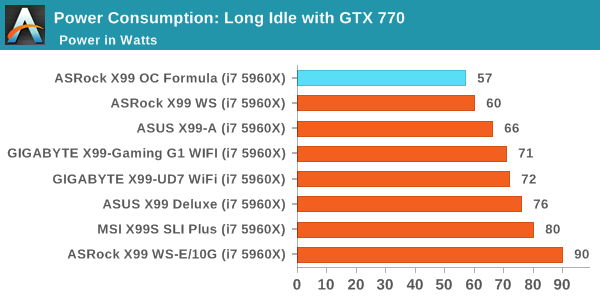
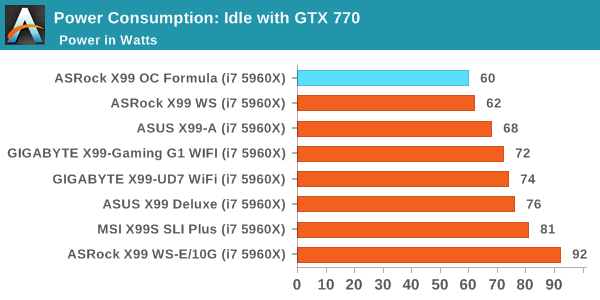
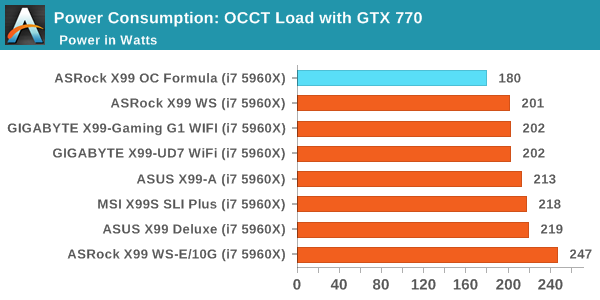
In our power testing I was astounded to see the X99 OC Formula feature under 60W for idle and over 20W less than other X99 boards during a CPU load. On closer inspection I found the culprit – the motherboard implements only 0.954 volts to the CPU under load. This is around 0.075 volts less than most other motherboards, and 0.250 volts less than others. This accounts for the big shift in power usage at CPU load during stock performance.
Windows 7 POST Time
Different motherboards have different POST sequences before an operating system is initialized. A lot of this is dependent on the board itself, and POST boot time is determined by the controllers on board (and the sequence of how those extras are organized). As part of our testing, we look at the POST Boot Time using a stopwatch. This is the time from pressing the ON button on the computer to when Windows 7 starts loading. (We discount Windows loading as it is highly variable given Windows specific features.)
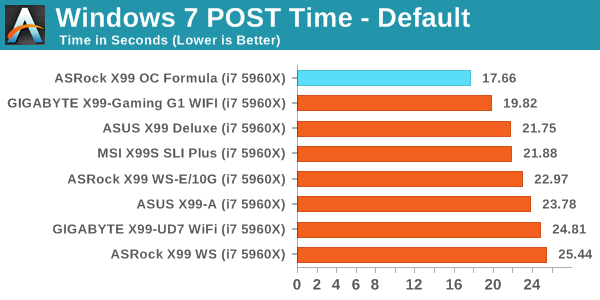
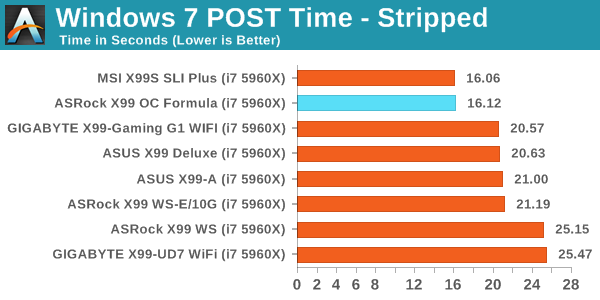
The OC Formula sets a new benchmark for our X99 POST times, being the first board under 18 seconds for stock settings.
Rightmark Audio Analyzer 6.2.5
Rightmark:AA indicates how well the sound system is built and isolated from electrical interference (either internally or externally). For this test we connect the Line Out to the Line In using a short six inch 3.5mm to 3.5mm high-quality jack, turn the OS speaker volume to 100%, and run the Rightmark default test suite at 192 kHz, 24-bit. The OS is tuned to 192 kHz/24-bit input and output, and the Line-In volume is adjusted until we have the best RMAA value in the mini-pretest. We look specifically at the Dynamic Range of the audio codec used on board, as well as the Total Harmonic Distortion + Noise.
Dynamic Range of ASRock X99 OC Formula
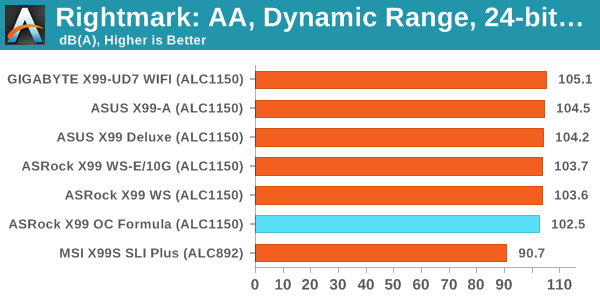
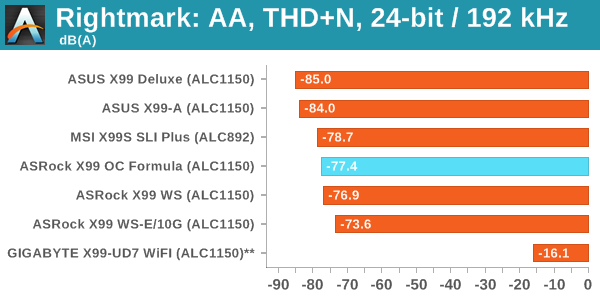
Audio results are around what we might expect with the dynamic range being over 100 dB but the THD+N is low compared to some of the other boards we have tested.
USB Backup
For this benchmark, we transfer a set size of files from the SSD to the USB drive using DiskBench, which monitors the time taken to transfer. The files transferred are a 1.52 GB set of 2867 files across 320 folders – 95% of these files are small typical website files, and the rest (90% of the size) are small 30 second HD videos. In an update to pre-Z87 testing, we also run MaxCPU to load up one of the threads during the test which improves general performance up to 15% by causing all the internal pathways to run at full speed.
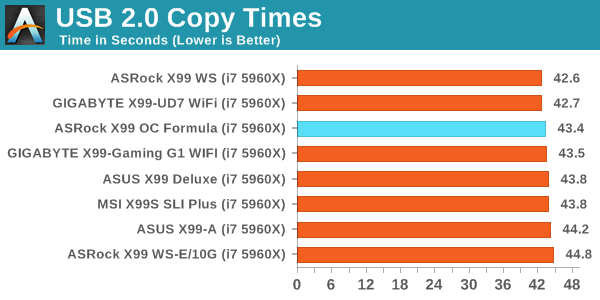
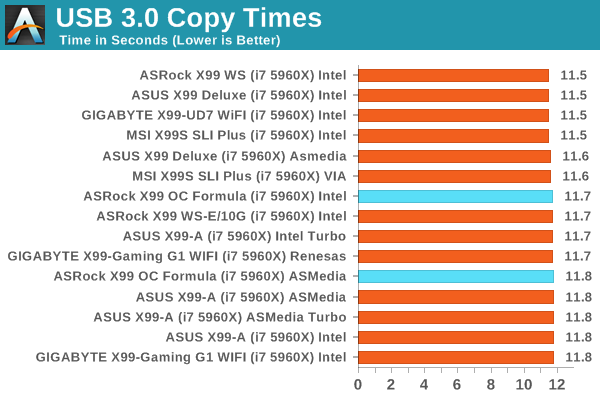
USB performance was middling at best.
DPC Latency
Deferred Procedure Call latency is a way in which Windows handles interrupt servicing. In order to wait for a processor to acknowledge the request, the system will queue all interrupt requests by priority. Critical interrupts will be handled as soon as possible, whereas lesser priority requests such as audio will be further down the line. If the audio device requires data, it will have to wait until the request is processed before the buffer is filled.
If the device drivers of higher priority components in a system are poorly implemented, this can cause delays in request scheduling and process time. This can lead to an empty audio buffer and characteristic audible pauses, pops and clicks. The DPC latency checker measures how much time is taken processing DPCs from driver invocation. The lower the value will result in better audio transfer at smaller buffer sizes. Results are measured in microseconds.
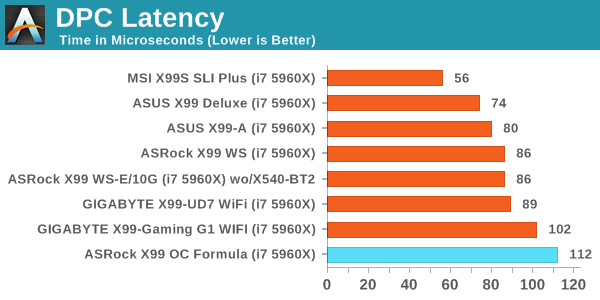
Anything under 200 microseconds is a very good result, but due to X99 being very good for DPC Latency we lower the bar to 100 microseconds as a target. The OC Formula misses this by a small margin, but the overall result is still reasonable.











17 Comments
View All Comments
ZeDestructor - Tuesday, December 30, 2014 - link
Some of us run triple or quad SLI, or SLI with a bunch of other PCIe cards. For us, ATX is where we start.spacefrog - Tuesday, December 30, 2014 - link
Do you mean mini-ITX (17*17cm) or MicroATX (24.4*24.4 cm)?I don't think there is a mini-ITX LGA 2011 mobo. If MicroATX then there is EVGA X99 Micro.
For LGA 1150 there are many options.
Gigaplex - Wednesday, December 31, 2014 - link
My main rig is Mini-ITX but it feels like there's just a bit too much compromise for RAM and storage options (4 SATA, I'd like 6-8 ports). Next build will probably be Micro-ATXRatman6161 - Tuesday, December 30, 2014 - link
"Extreme overclocking on X99 is a niche within a niche. Haswell-E is already limited to those with enough financial backing" To that I say: not necessarily. I'm lucky enough to live near a Microcenter location and they are selling an i7-5820K + motherboard bundle for $520. I'm pretty sure way back when I built my current system with a 2600K + Z68 MB it cost almost that much. I'd kind of be interested in seeing what could be done with such a lower cost option.chrnochime - Friday, January 2, 2015 - link
Not very many people have a MC nearby, so that price is only accessible to some, not the majority of PC hobbyists.catavalon21 - Tuesday, December 30, 2014 - link
Table above shows a 3 year warranty, but the product page seems to show it at 5 years...http://www.asrock.com/support/note/OCFormula5YearW...SantaAna12 - Friday, January 2, 2015 - link
Another "overclocking" review..Did I.miss the chart comparing this Asrock to it's competition?